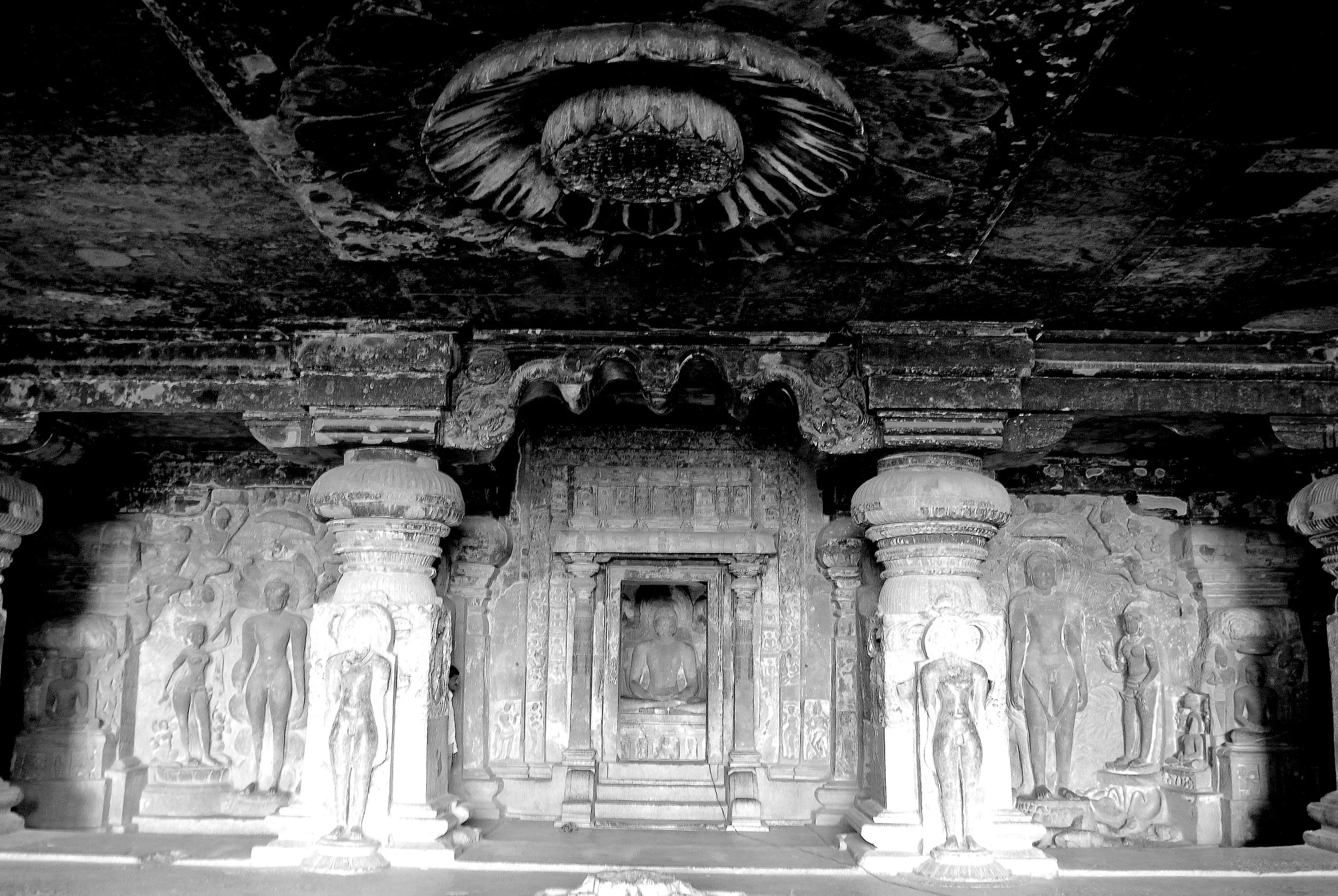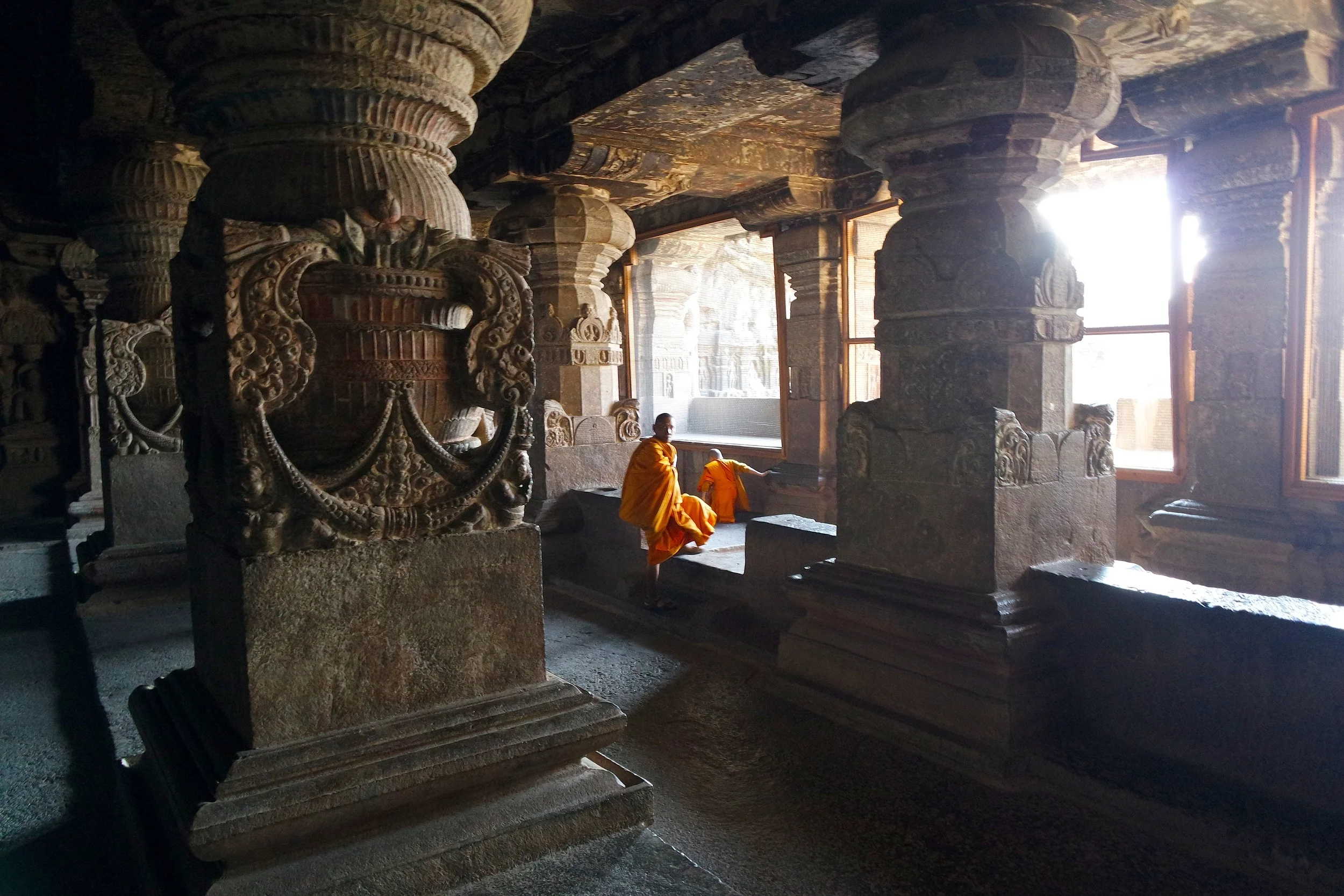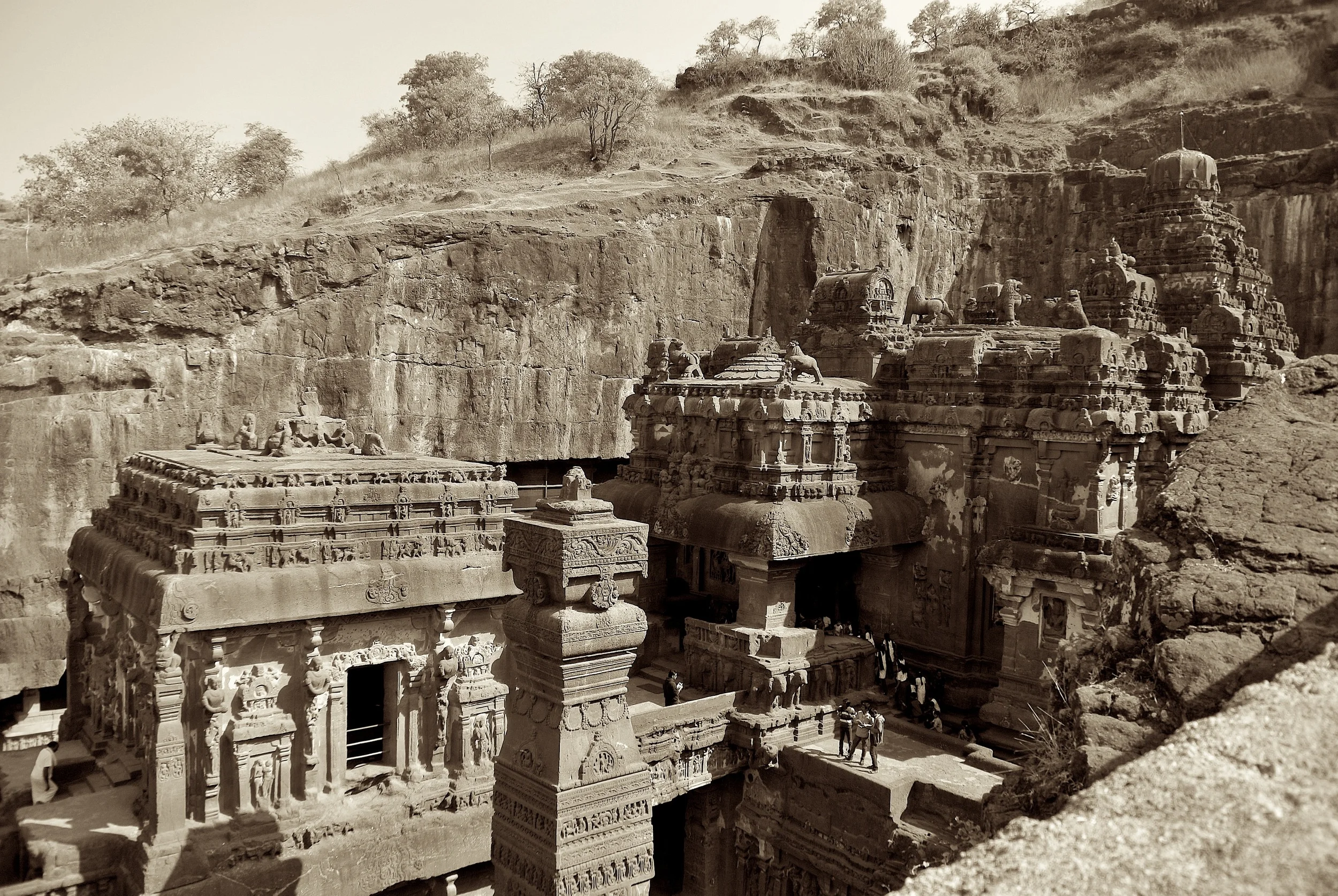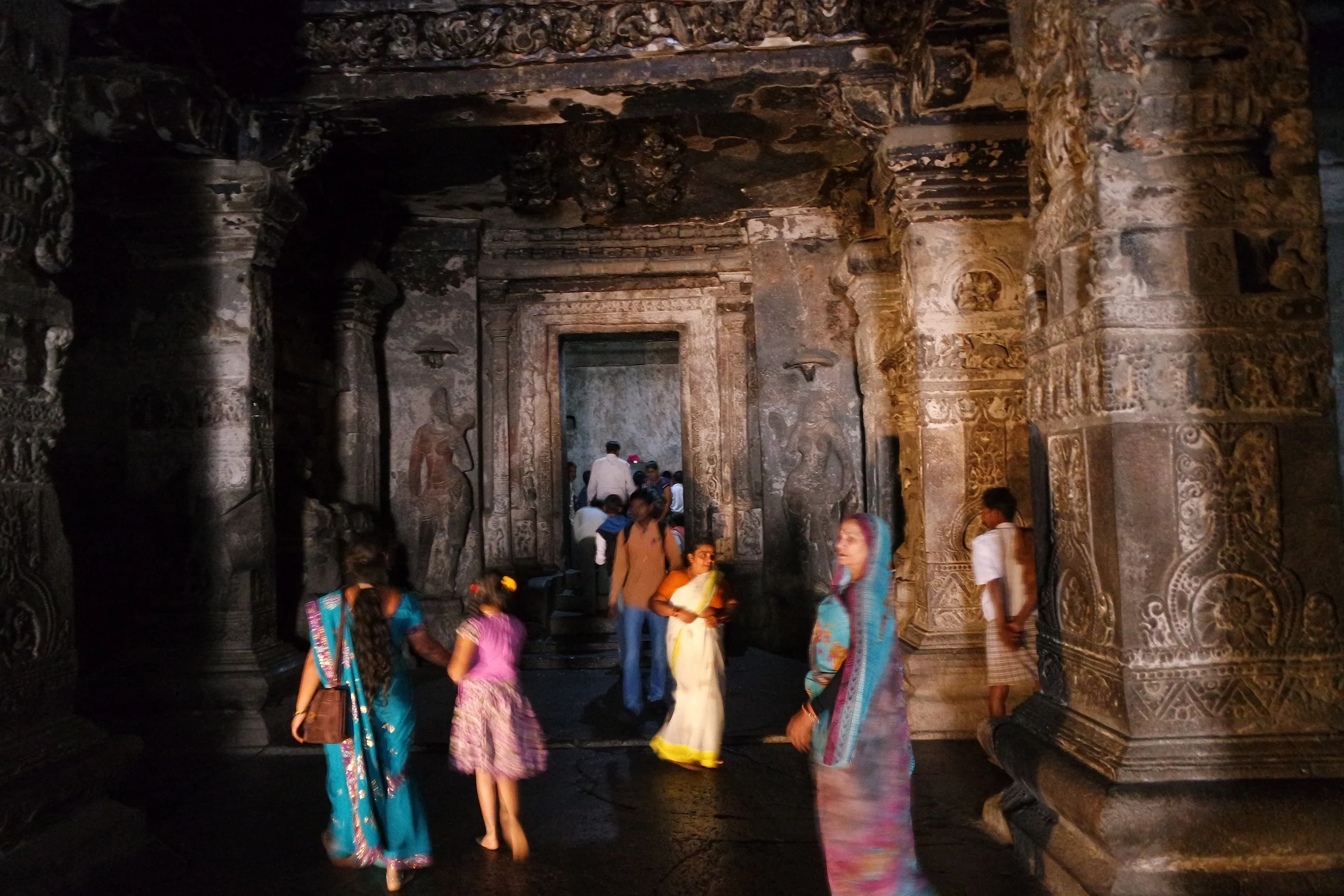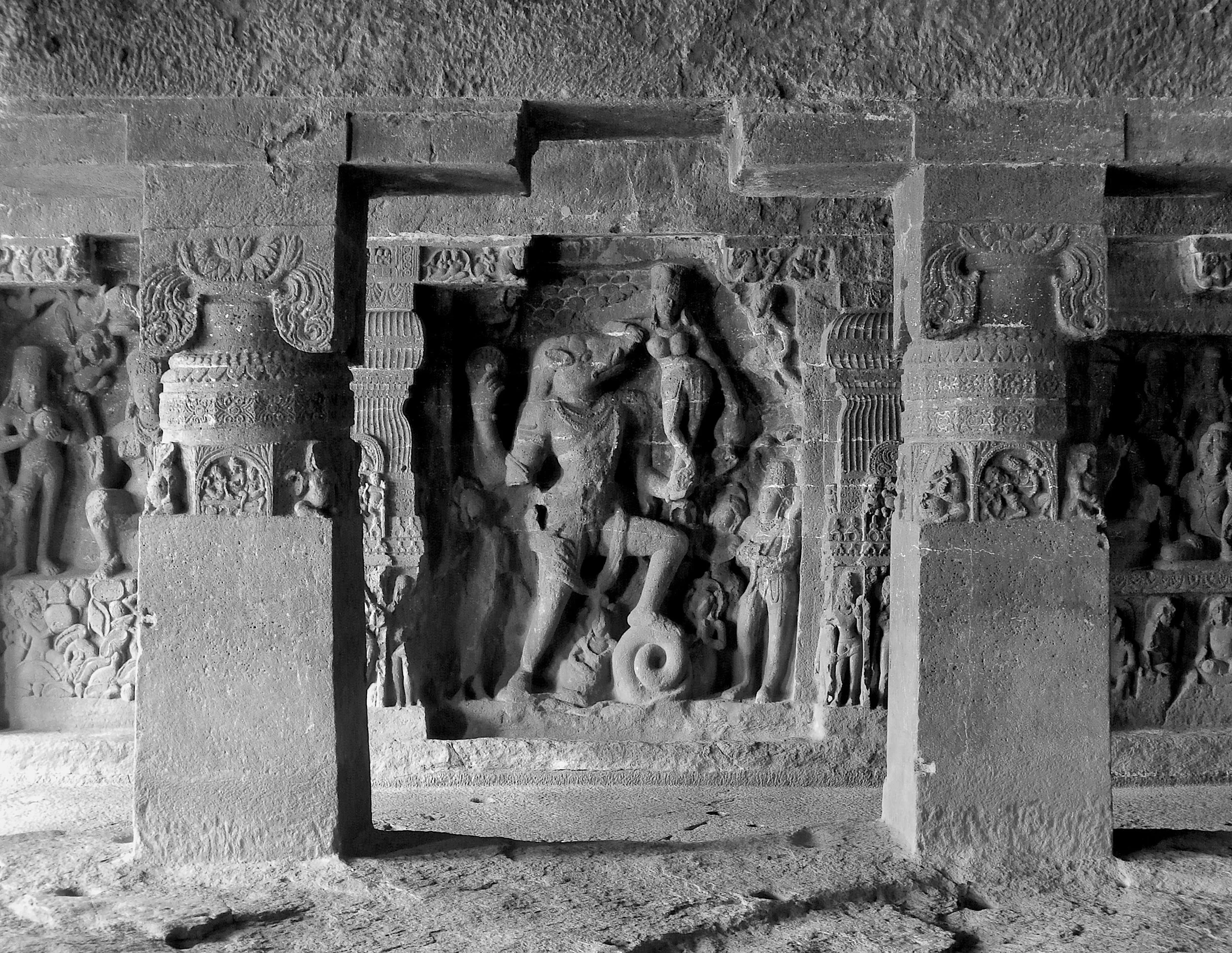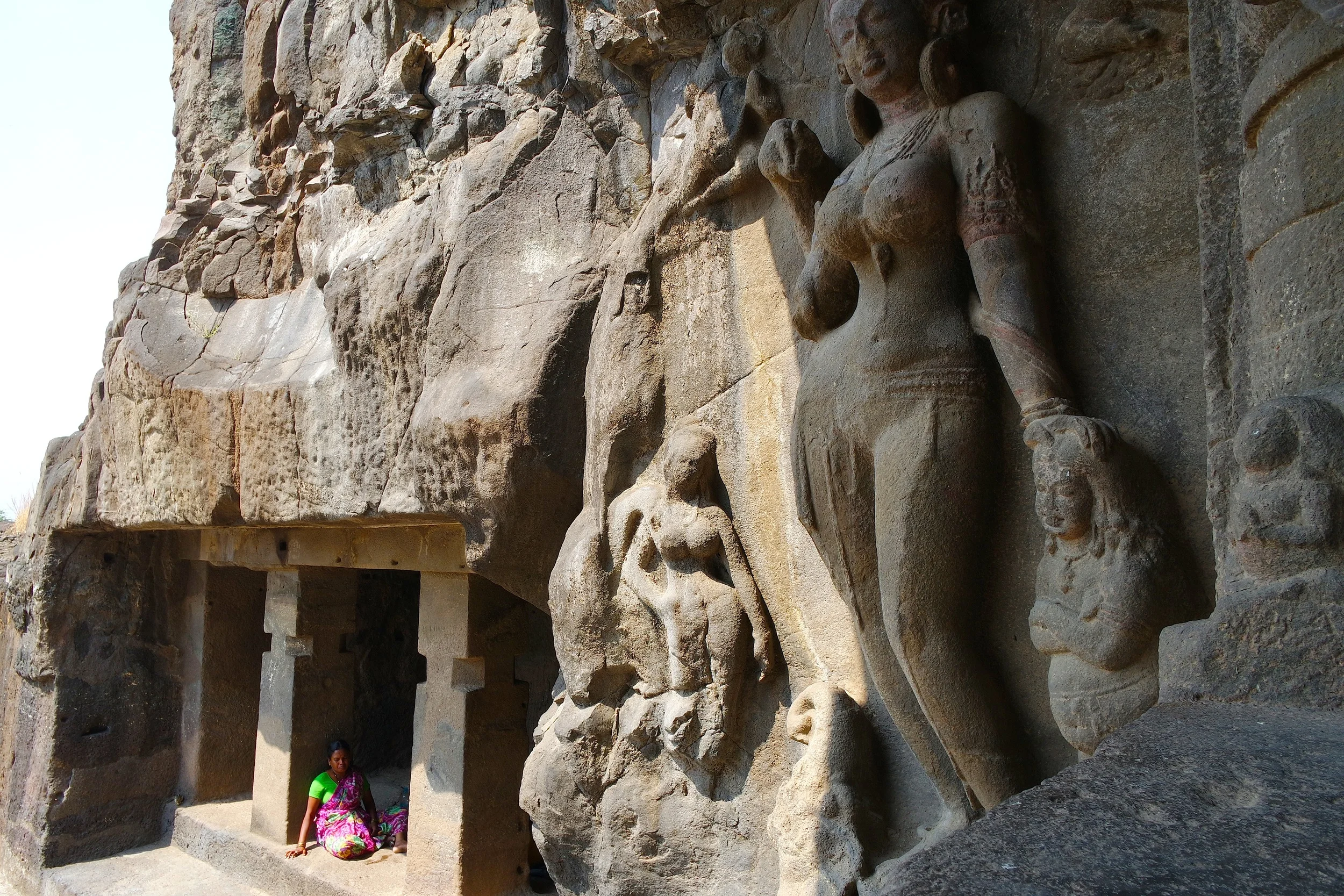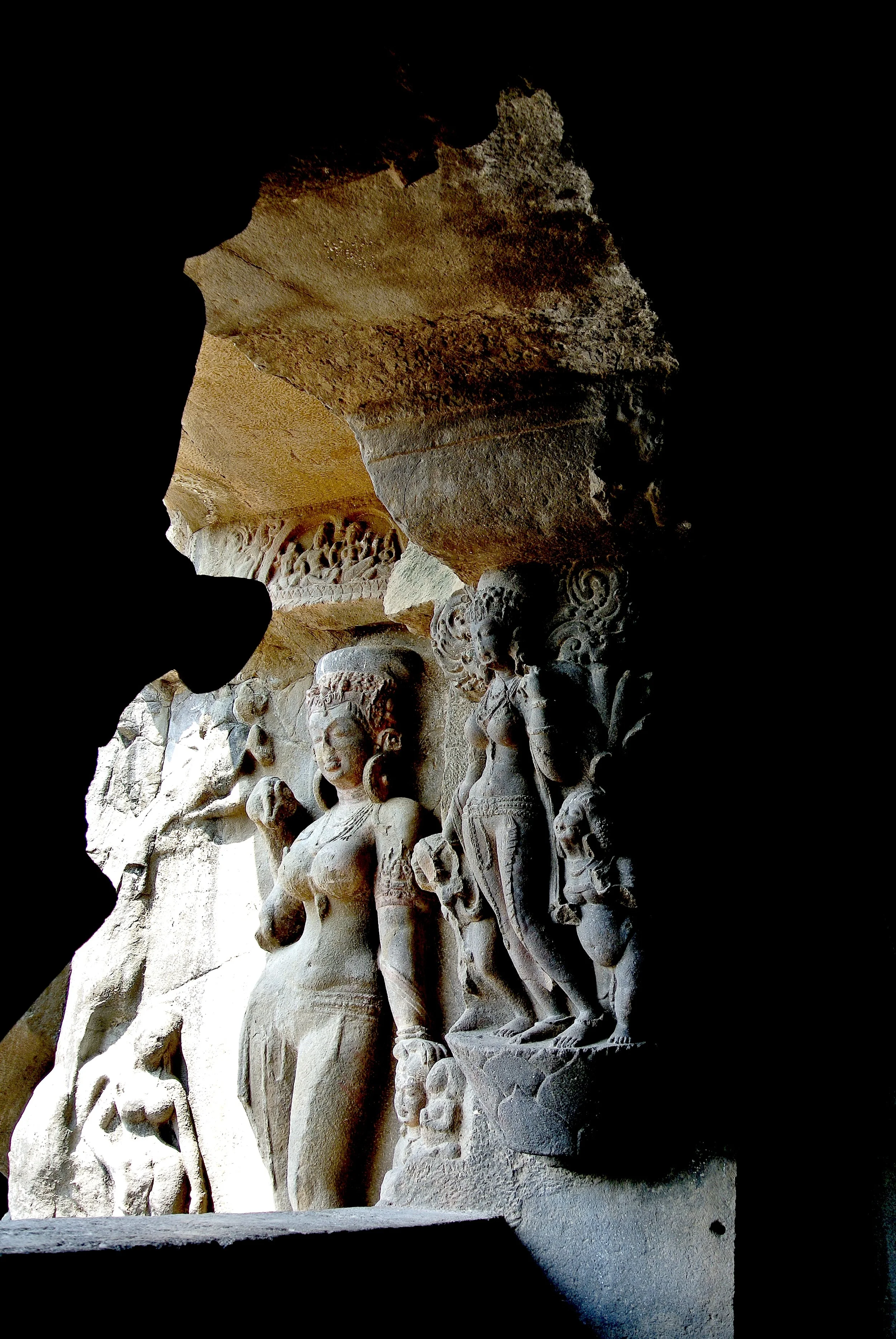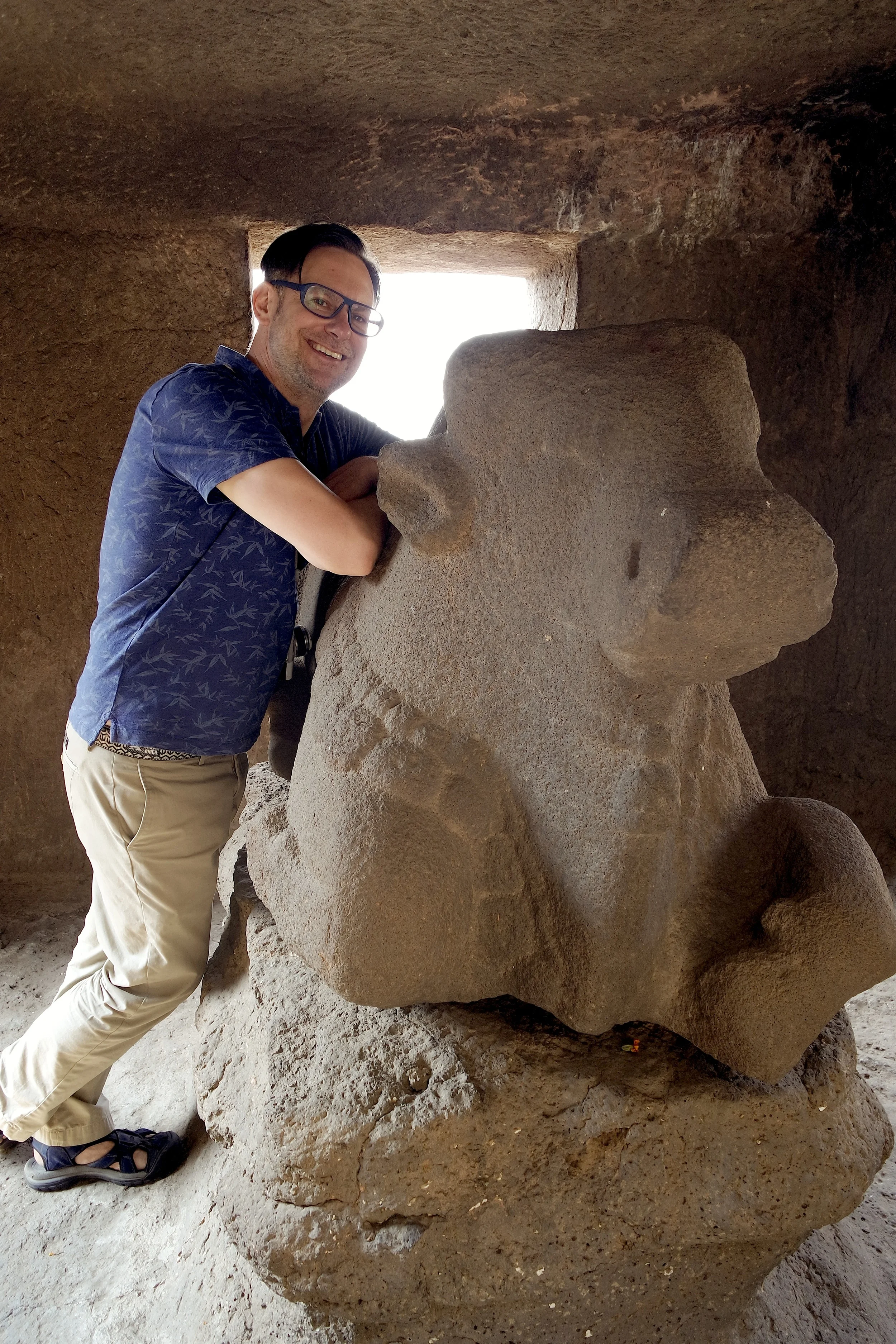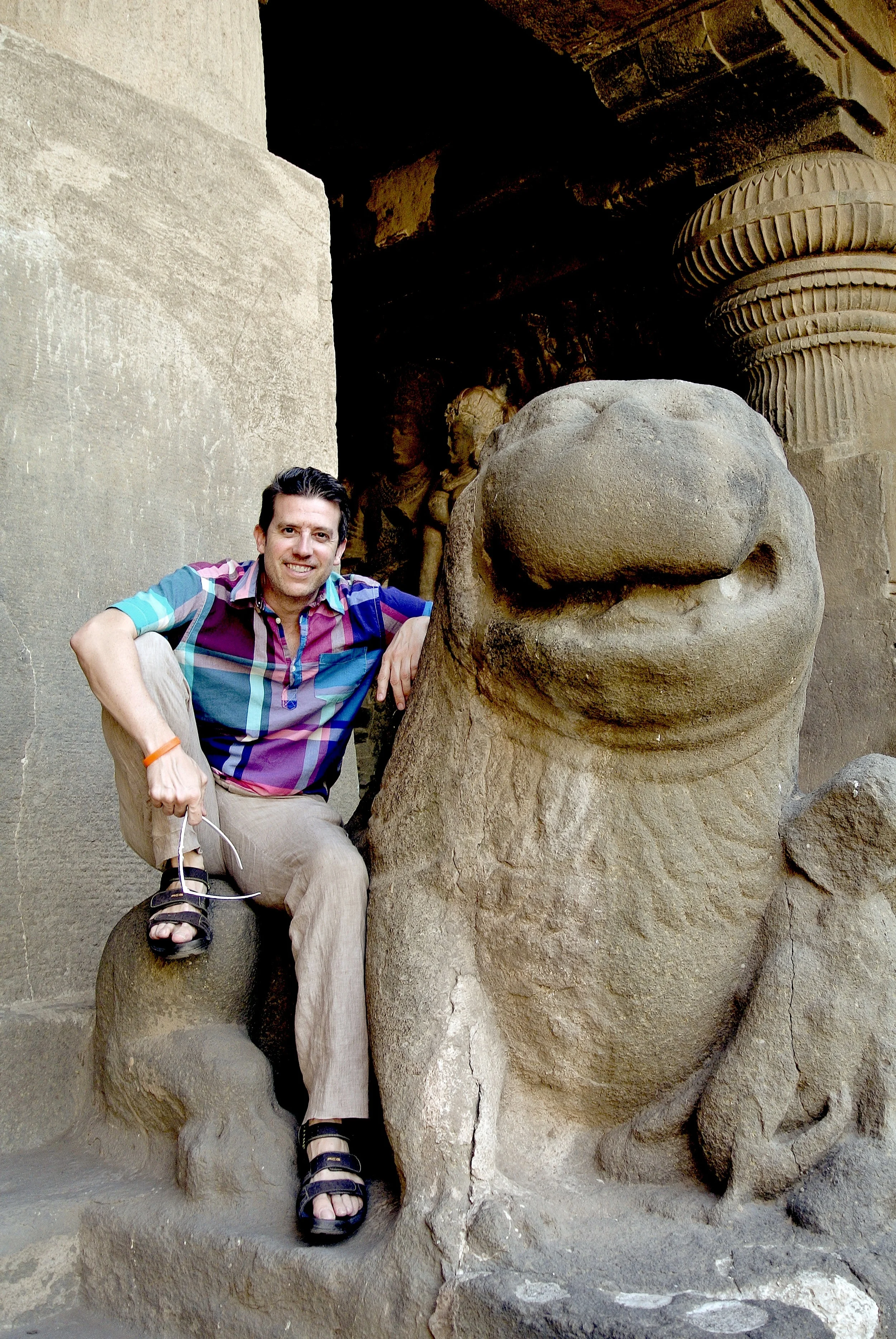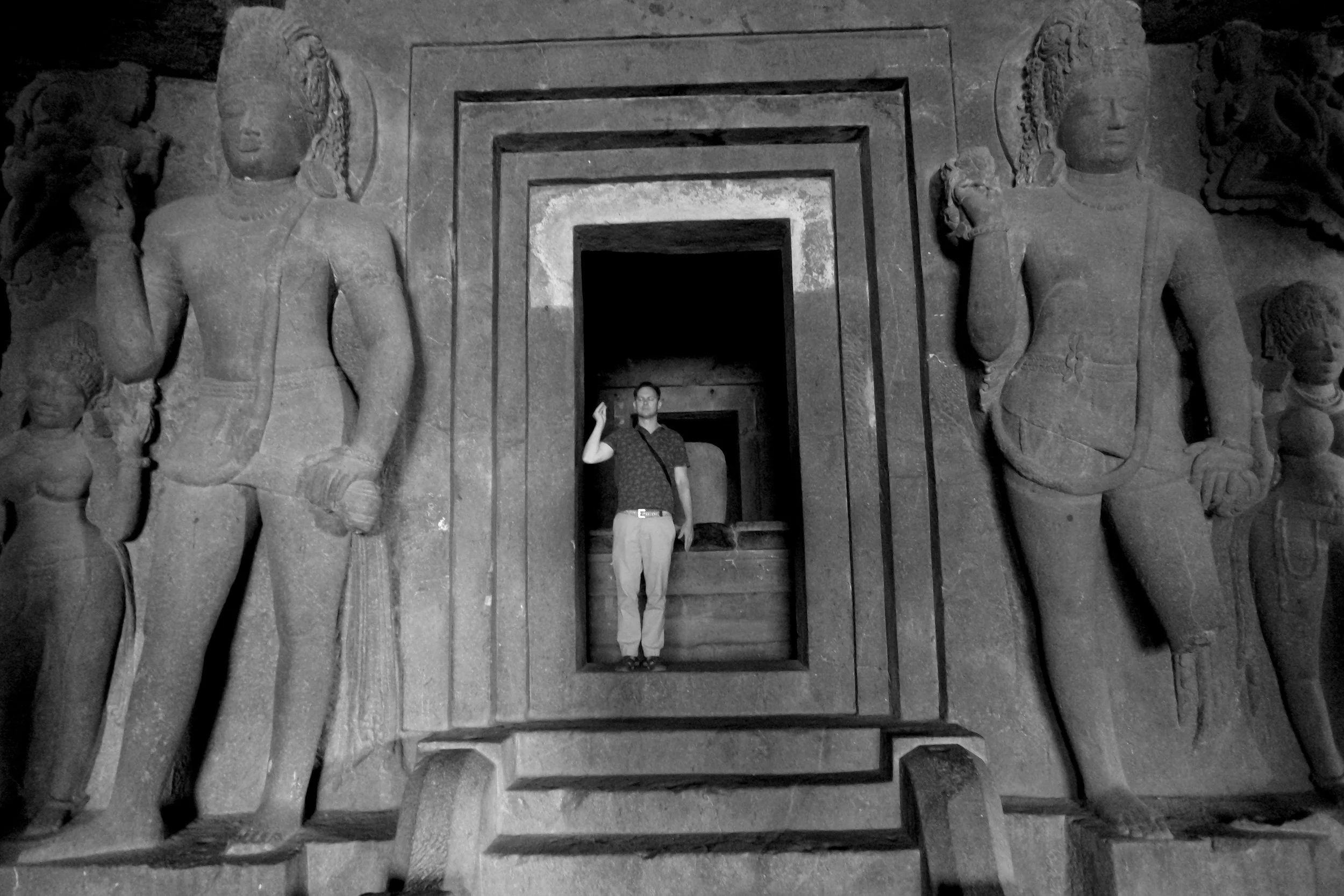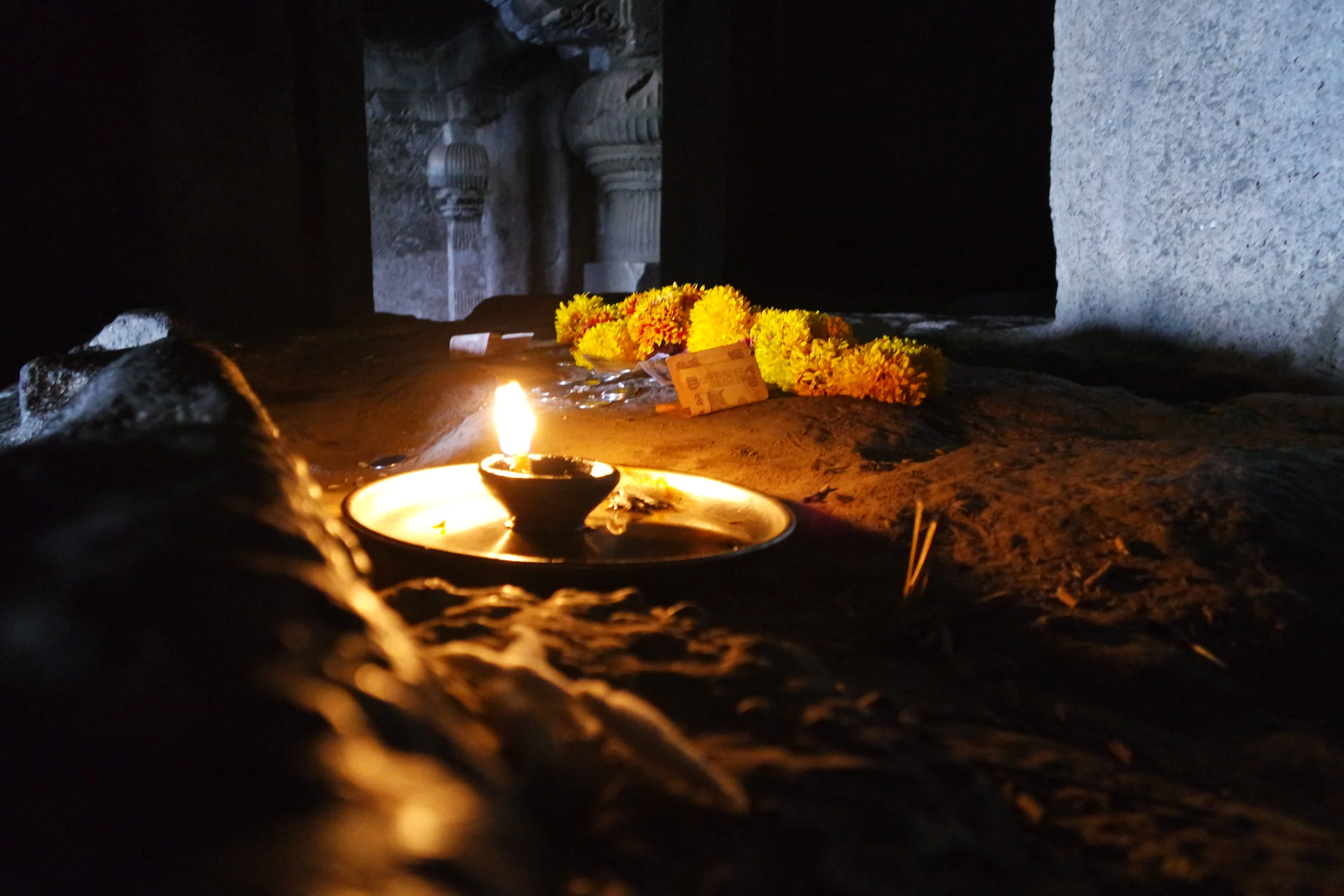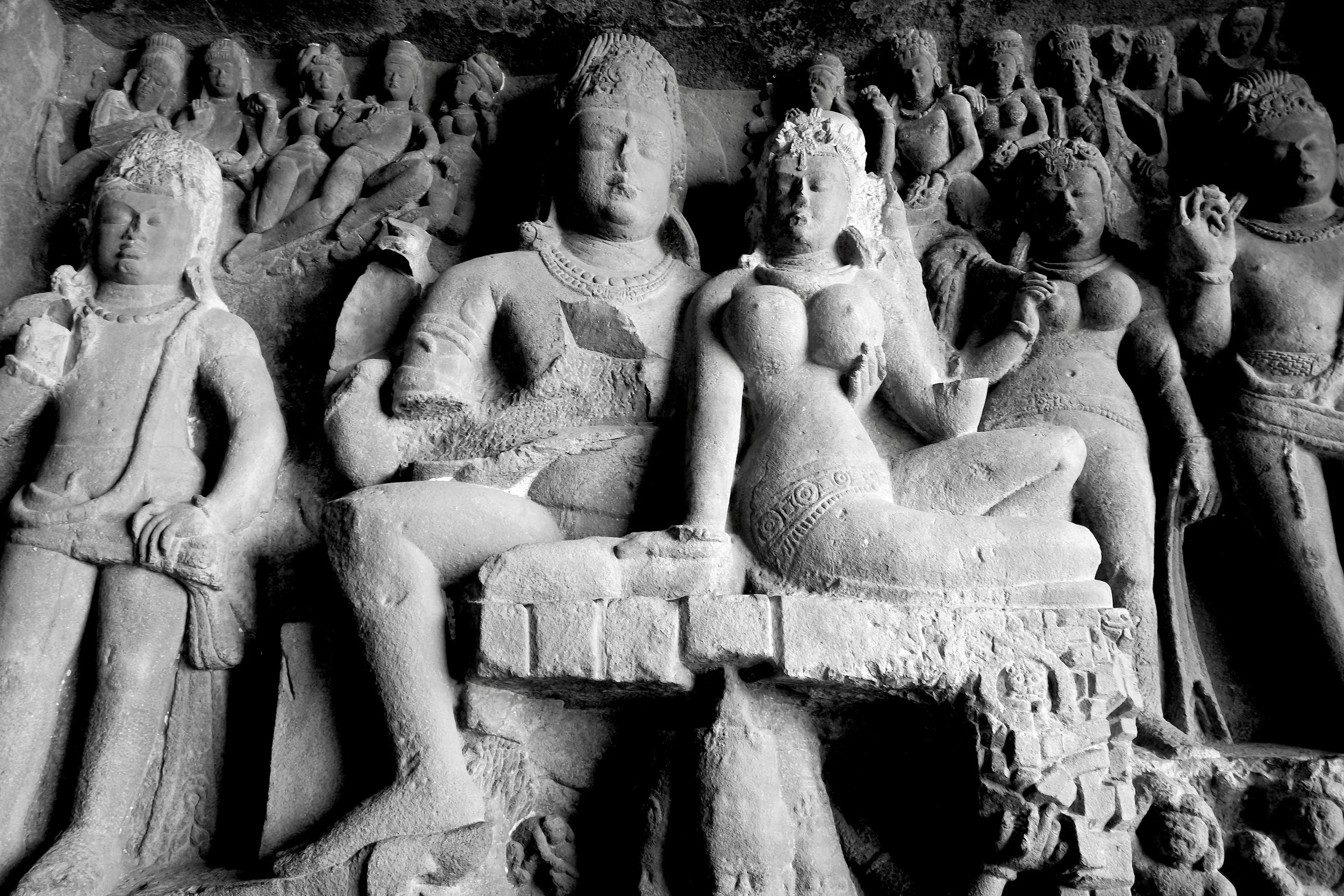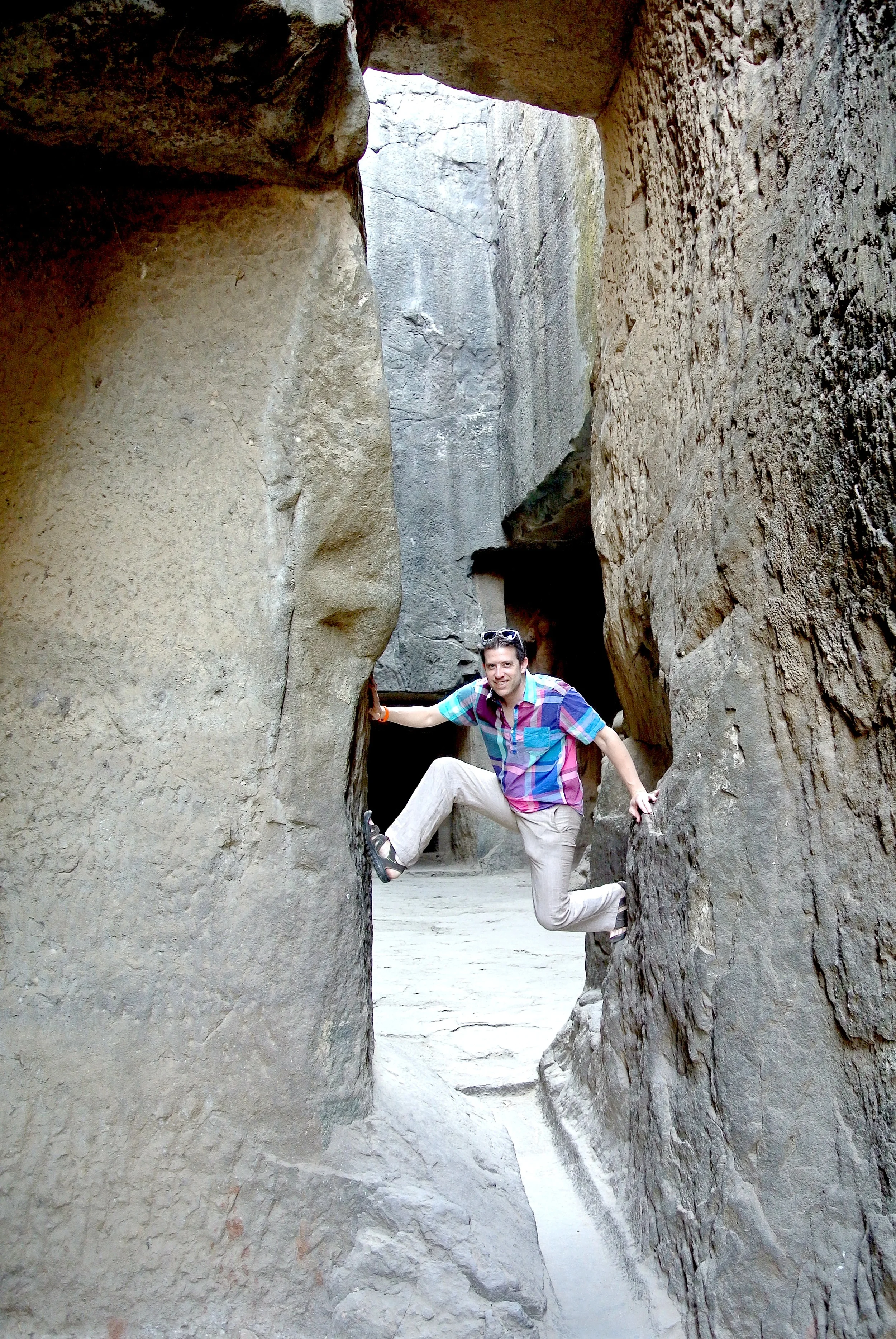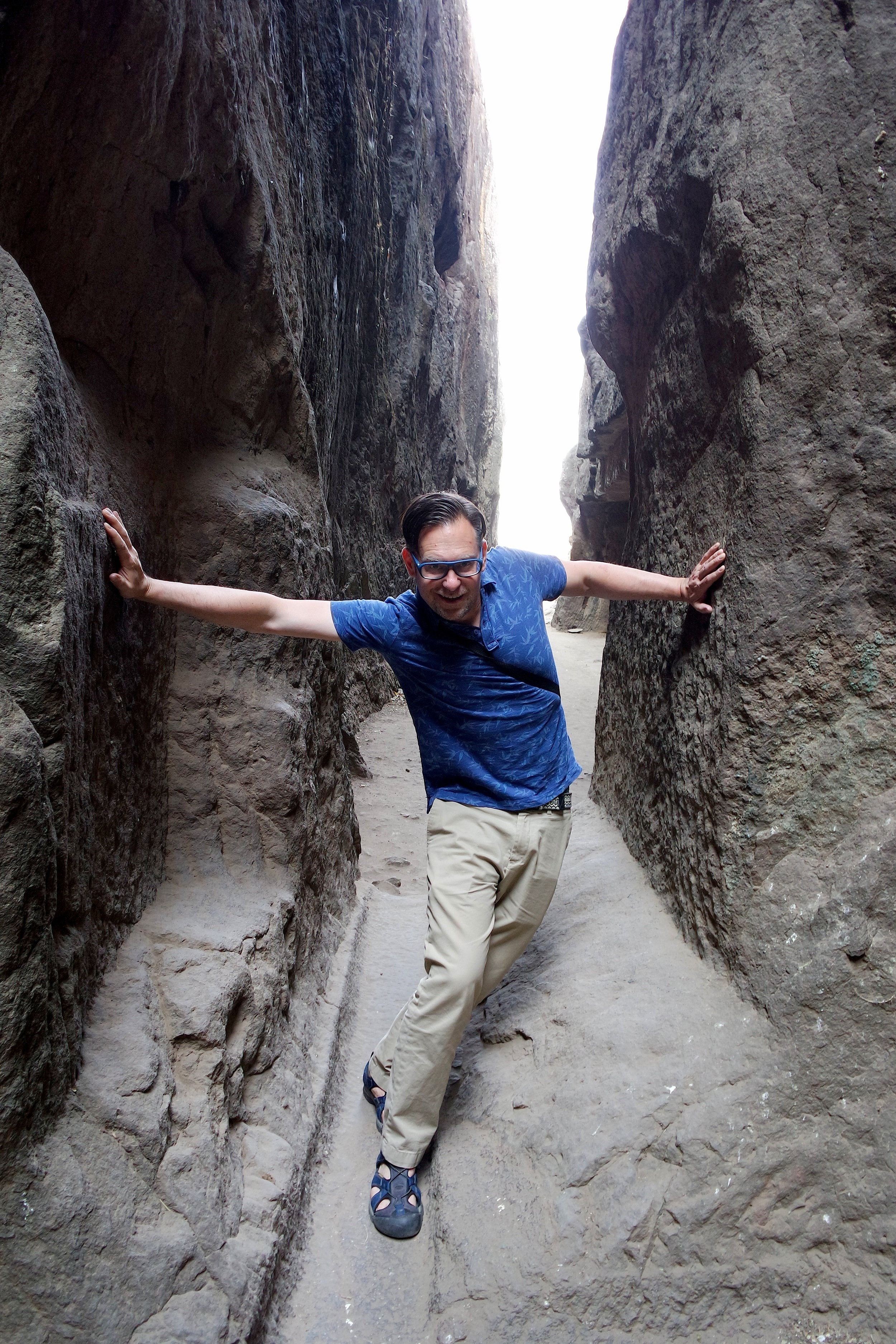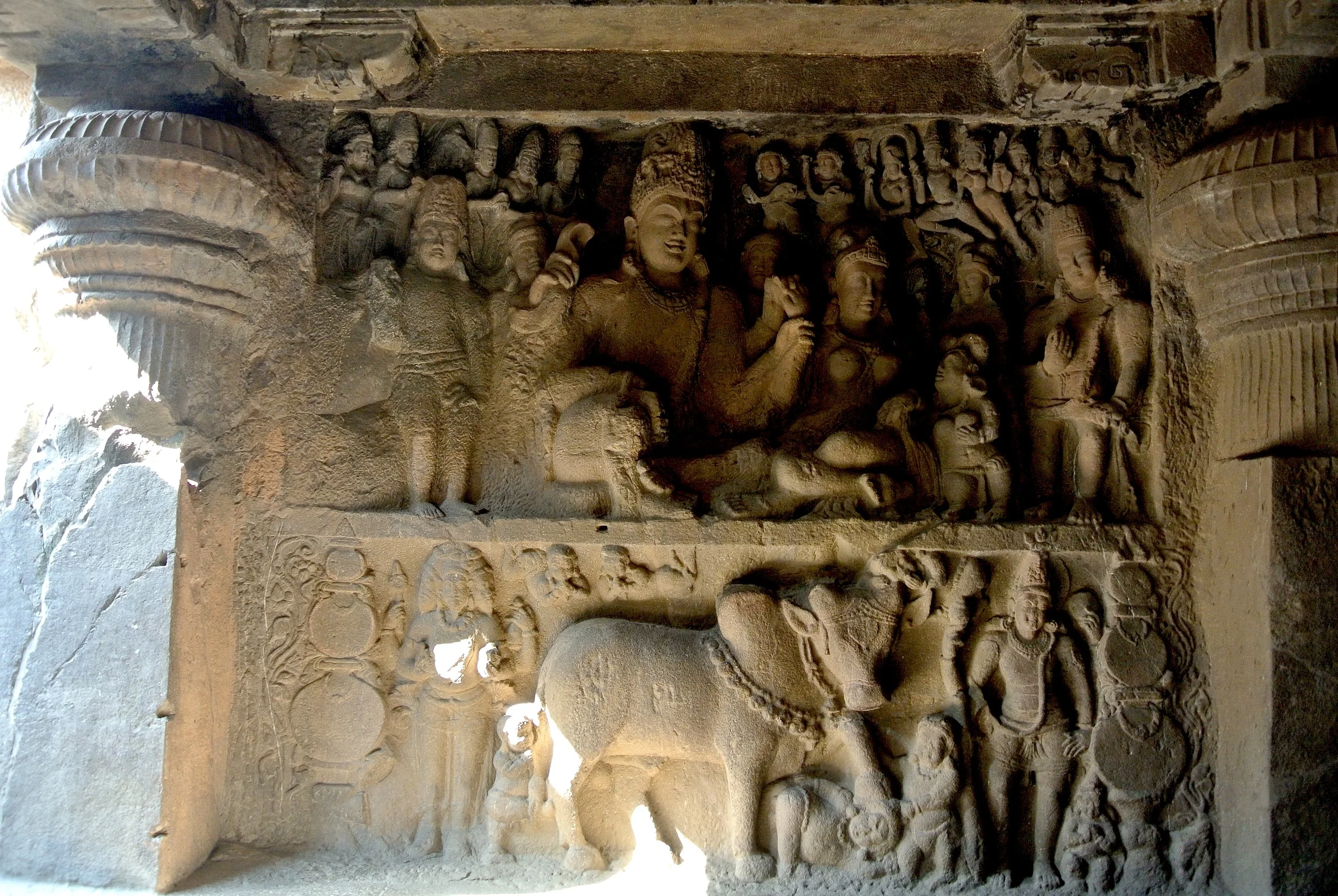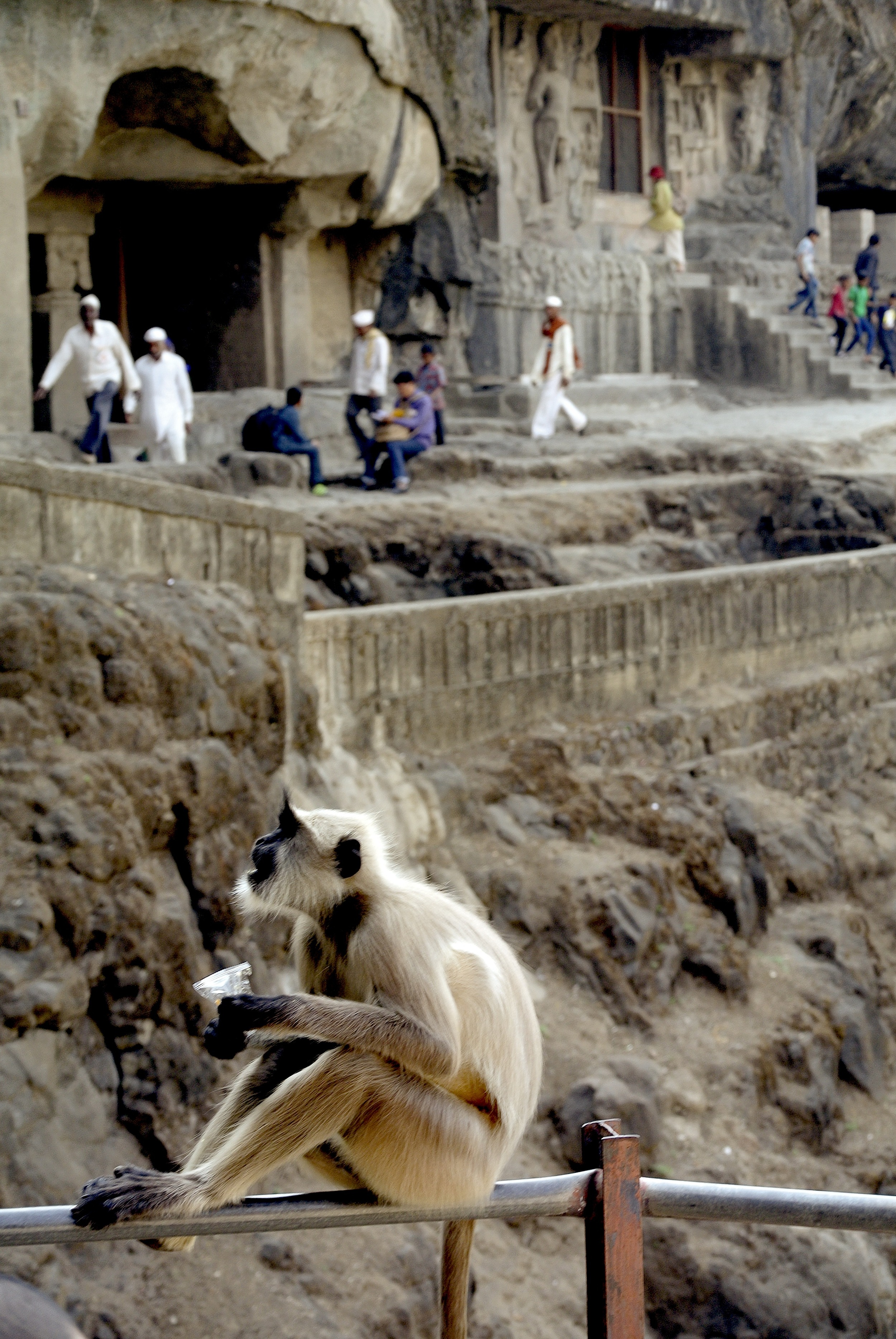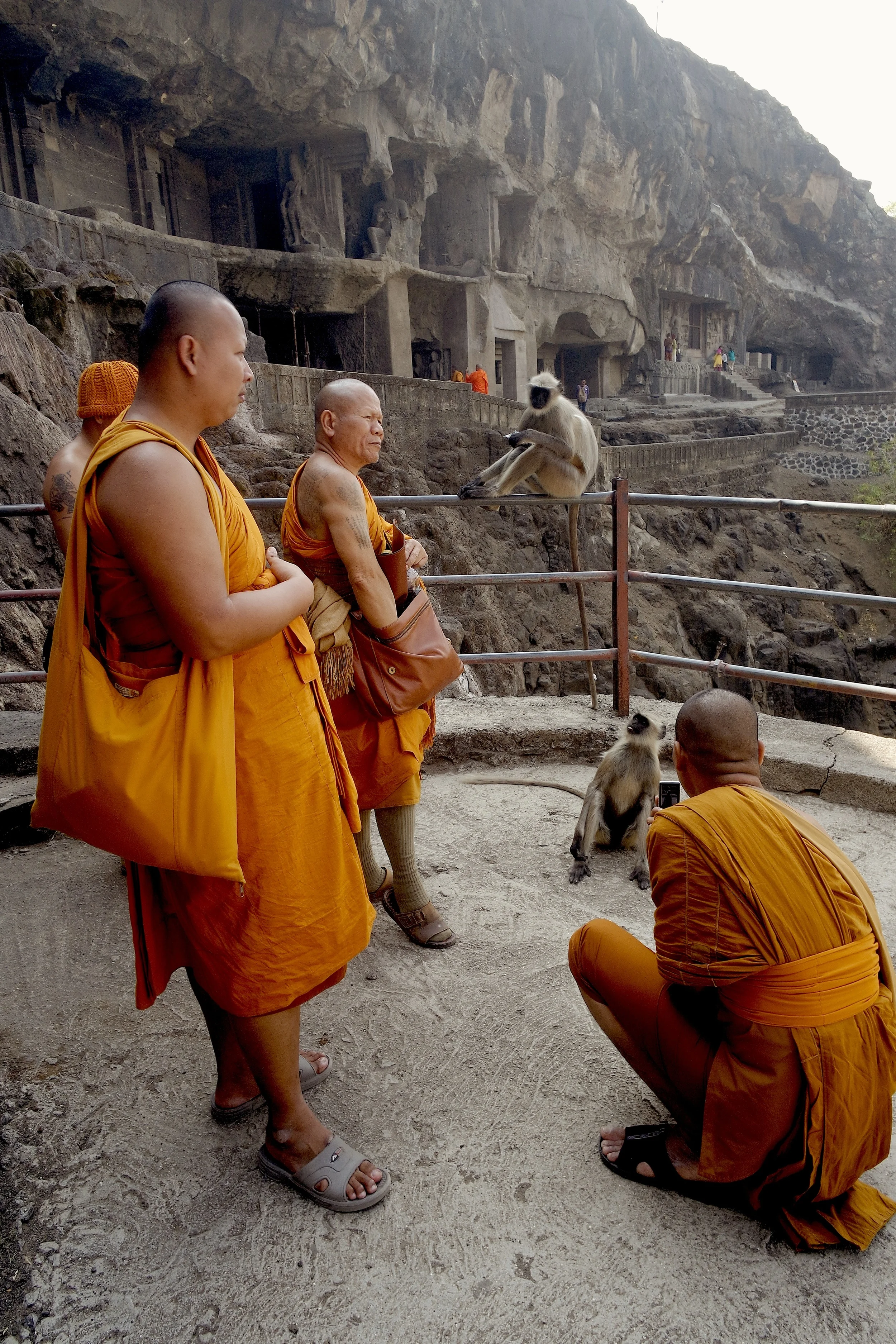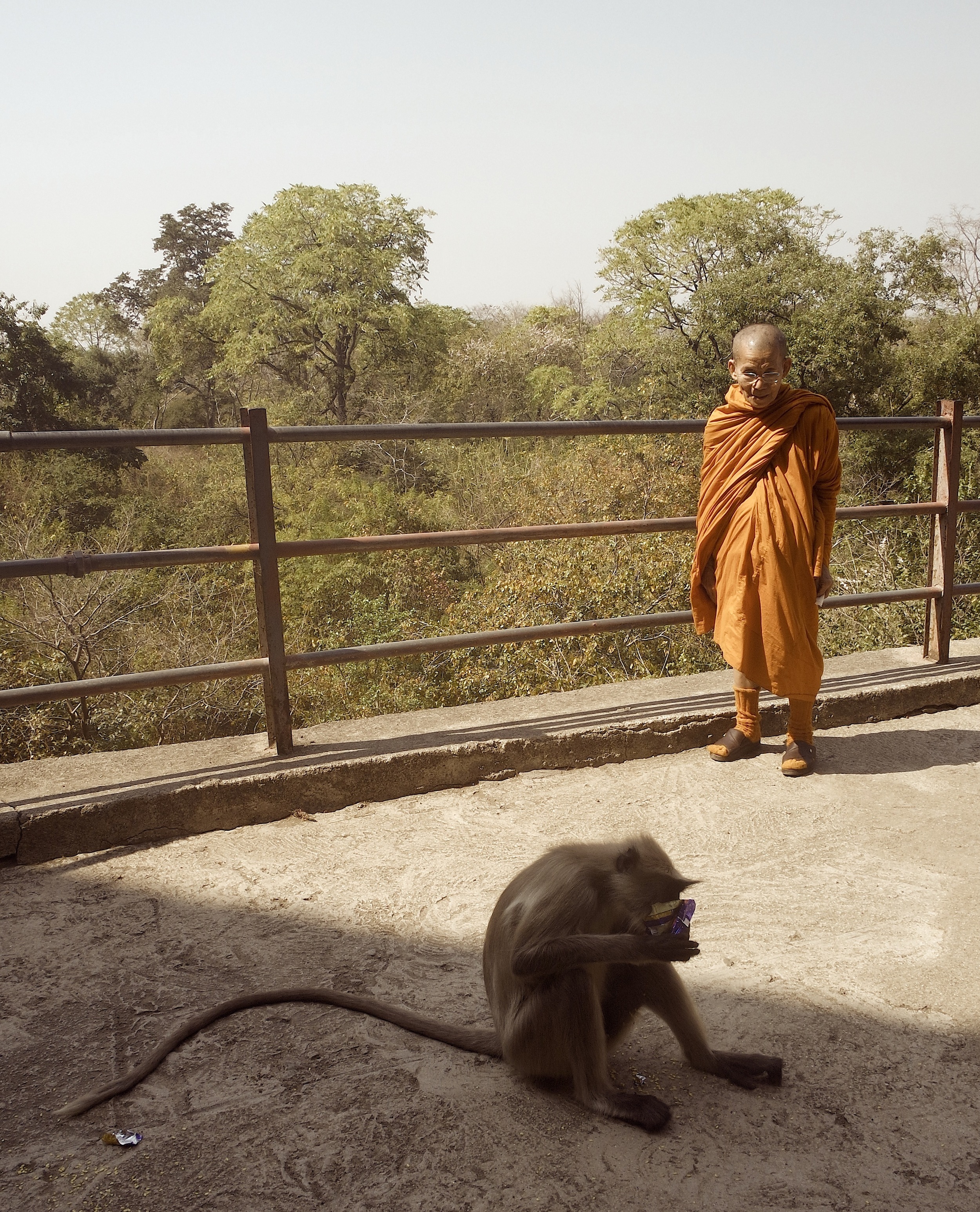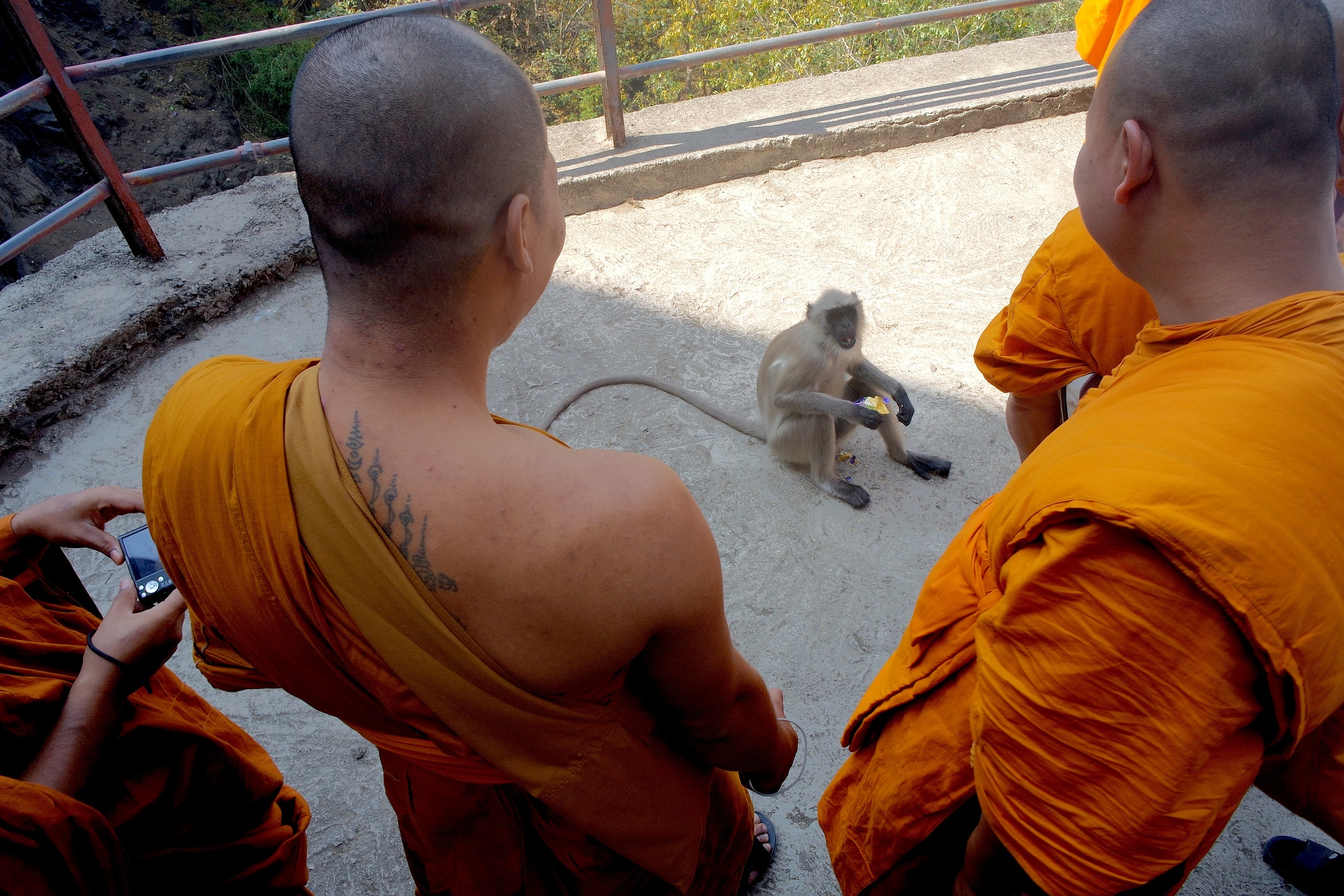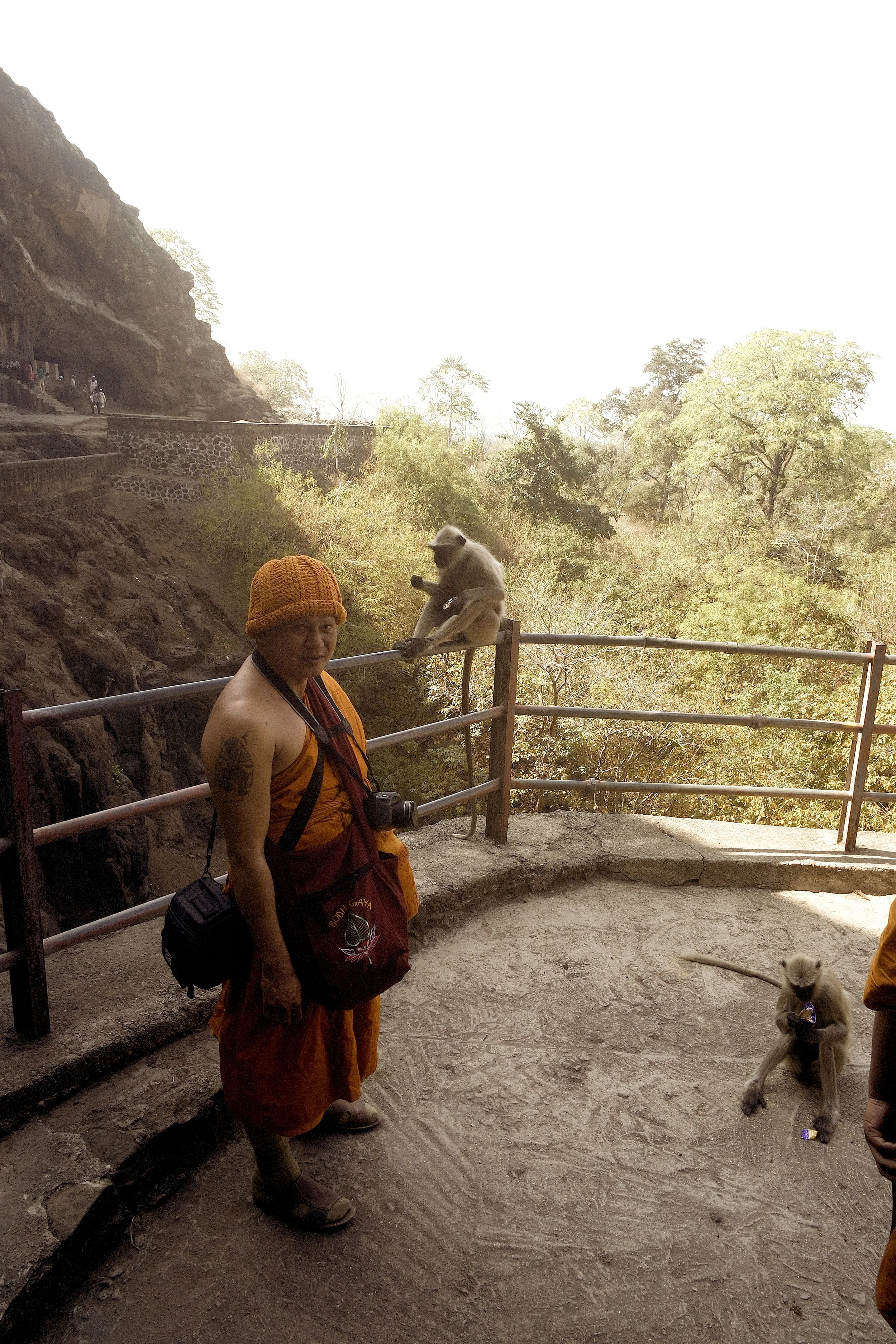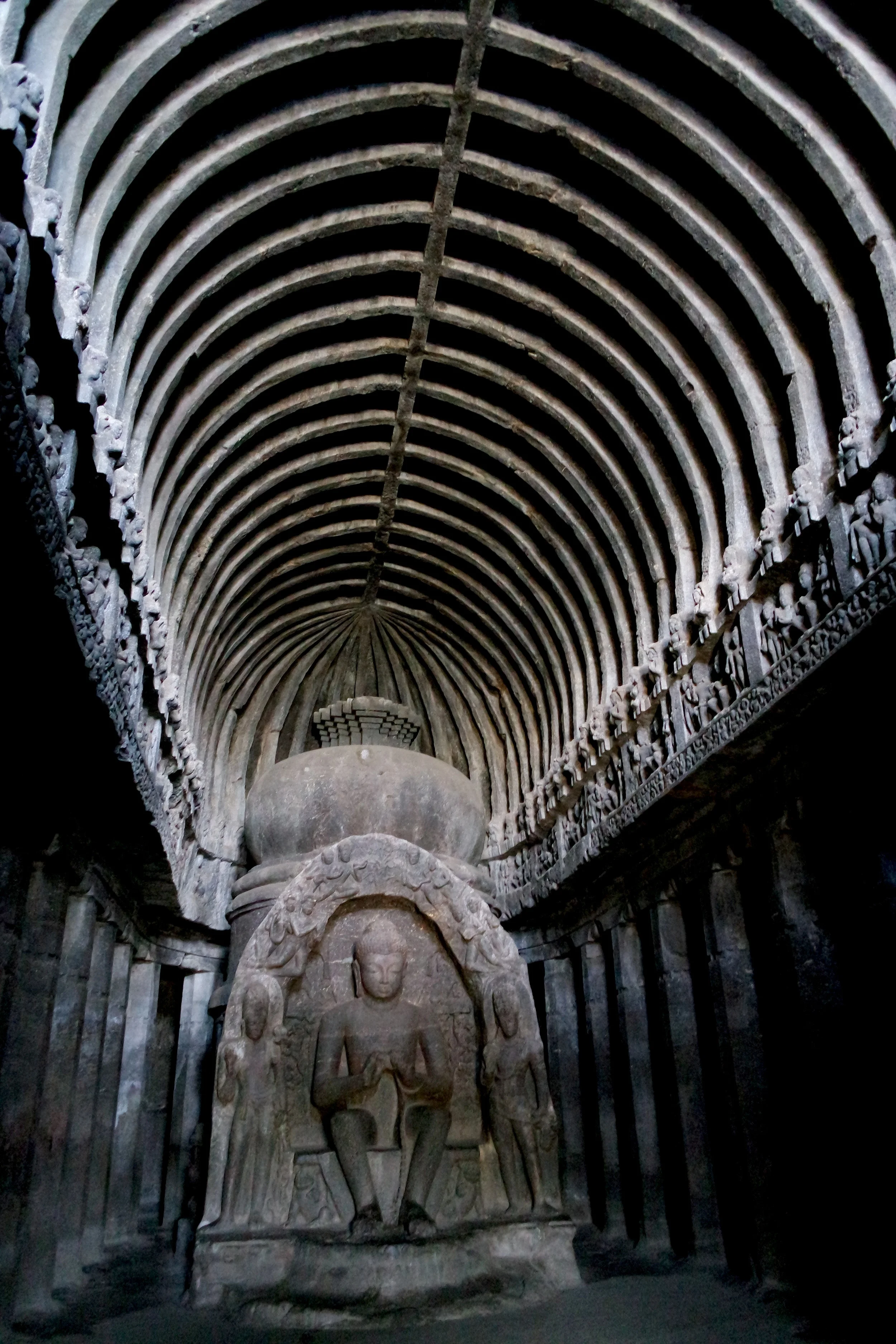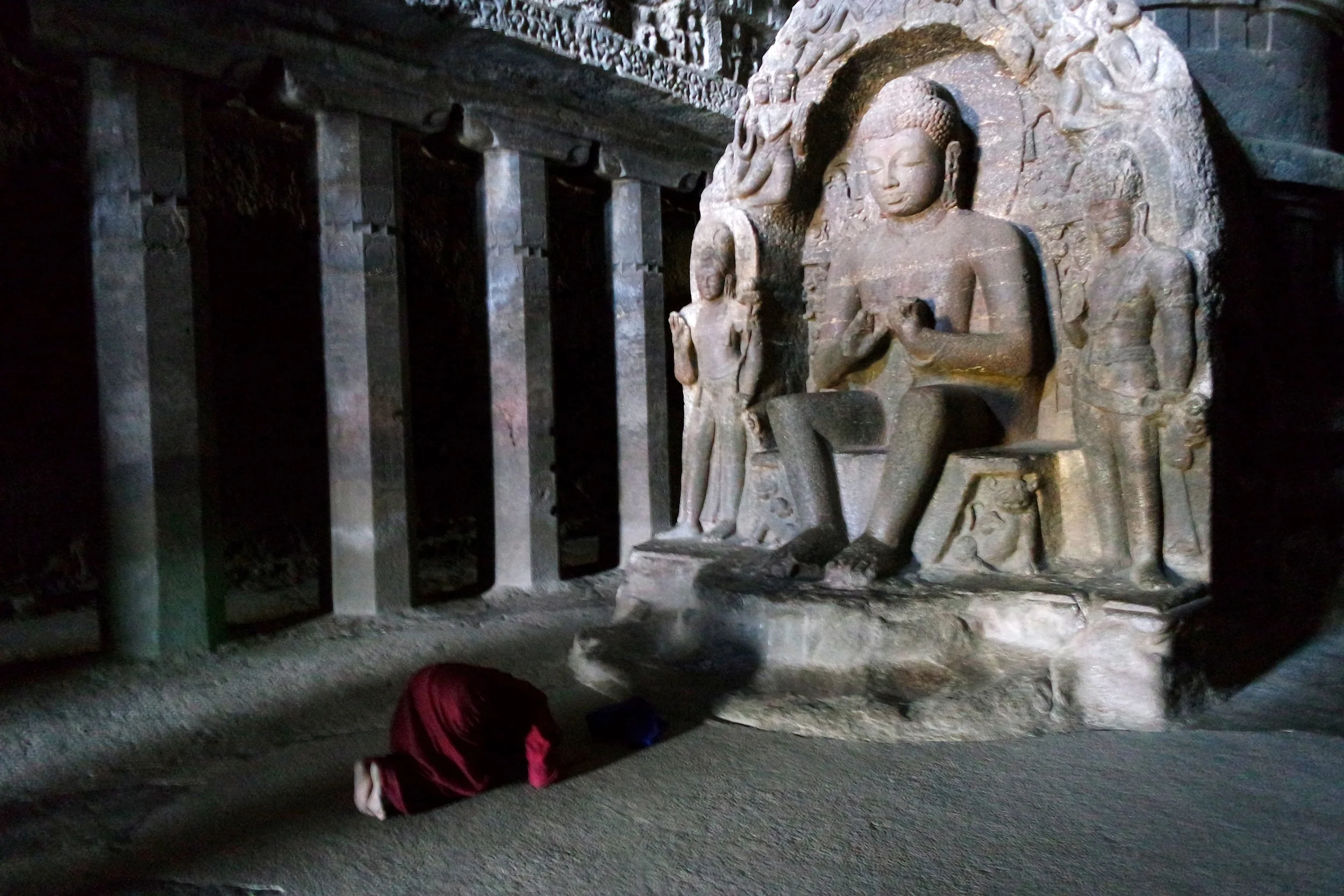Two women sit on the steps of the massive Hindu temple at Ellora Caves in India
Stunning examples of Indian architecture, Ellora features Buddhist, Hindu and Jain sanctuaries carved out of the side of the hills.
There must be something super-sacred about this spot. Practitioners of three different religions built halls of worship in the Ellora Caves: Jains, Hindus and Buddhists.
Something I found remarkable about Ellora is that the varying structures operating side-by-side illustrated the tolerance of religious belief.
“It’s one of the coolest ancient temples we’ve ever been in. This extraordinary multi-storied temple was carved out of a single rock from the top down. ”
Now a UNESCO World Heritage Site, the 34 sanctuaries were constructed from 600 to 1000 CE. It’s likely that the Buddhist caves were the earliest, consisting mostly of viharas or monasteries, including living quarters — though there’s some debate as to whether the Hindu complex preceded this.
The Ellora Caves are located much closer to Aurangabad and less remote than Ajanta. As we neared the entrance to the complex, we were excited to catch a glimpse of langur monkeys, traditionally identified with the Hindu god Hanuman.
RELATED: What to Know Before You Go
A testament to the engineering and skill of ancient India, these extraordinary caves are a combination of temples and monasteries hewn from the basalt cliffs. It's mind-boggling that such works of exquisite beauty were built with nothing more than rudimentary tools such as hammers and mason’s chisels.
The Jain Complex
A Buddhist monk in front of the entrance to a shrine at Cave 32
We began at the Jain caves, which drew their inspiration from the older caves and were the last of the temples to be built. While smaller in scale to the ones we were to encounter after, they were still intricately carved and impressive. The Indra Sabha, or Cave 32, features two stories of elaborately carved sculptures and a gorgeous balcony.
The figure in the central shrine is a jina, the Jain equivalent of an enlightened being. This one features Mahavir, the last of the Jain saviors.
Cave 32, the most spectacular of the Jain complex at Ellora
This statue in Cave 32 depicts either Ambika, the Jain mother goddess, or Siddhayika, a yakshini, or fairy-like creature. She's seated upon a lion beneath a tree heavy with fruit
Thai monks were gathered around a man wearing a white kurta with henna-colored hair — which signifies that he has undergone the hajj, having made the required pilgrimage to Mecca.
A jina, or enlightened being, at the back of Cave 32 at Ellora
Duke on the what's called the verandah, on the upper story of Cave 32 at Ellora
Monks in bright saffron robes can be seen throughout the Ellora complex, including the stunning second story of Cave 32
Outside Cave 32, we heard a shrill, high-pitched sound and scanned the escarpment for the source. I mistook it for a bird and was surprised to discover that the sound was coming from a chipmunk several feet above us.
Nearby Cave 31 contains representations of jains or tirthankaras, liberated souls who have succeeded in ending the cycle of rebirth and teach others the path to enlightenment.
An Amazing Hindu Temple
Kailasa, the large Hindu temple in the Ellora Caves complex
The second groups of caves are Hindu. The largest, Cave 16, is known as Kailasa or Kailashnath (Silver Mountain). Designed to recall Mount Kailash, the abode of Lord Shiva, it’s one of the coolest ancient temples we’ve ever been in. This extraordinary multi-storied temple was carved out of a single rock from the top down.
It originally had a thick coat of white plaster to make it appear like a snow-covered (silver) mountain.
The construction of this temple entailed the removal of an estimated 250,000 tons of rock over the course of a century. The complex covers an area twice the size of the Parthenon in Athens.
The main hall on the first floor has well-decorated balconies. A central door leads to the shrine at the back containing the great lingam. The small chamber was quite crowded with worshippers pressed around the phallic symbol, touching it reverently and leaving offerings of flowers and money.
Inside the Hindu temple, visitors bustled around, but it was almost eerily quiet
A carving of Shiva, the Hindu god of destruction, killing his demon son Andhaka for trying to abduct Parvati, the goddess of love and fertility, in the Kailasa temple at Ellora
We were there on a Saturday, which is a school day for Indian children. Because the cave complex is a popular field trip, it was abuzz with uniformed girls and boys. The girls were quieter and more composed, as opposed to the boys who howled and tore through the complex.
Everywhere we went, Indians wanted to take pictures of or with us. Eventually, Wally started giving them our camera so we could capture the moment as well
We were stopped by schoolboys who asked where we were from and if they could take a picture with us. They would thank us, giggling and running away after.
The Brahmanical Group
In the center of this carving in Cave 14, Varaha, the boar-headed avatar of Vishnu, rescues the Earth goddess by holding back the engulfing ocean
Cave 21, part of the Hindu temples at Ellora in India
Cave 21 has an attractive façade featuring figures of the river goddesses Ganga and Yamuna. Close by is Cave 22, in front of which is Nandi, the bull that Shiva rode around on, perched atop its usual raised platform.
The two river goddesses Ganga and Yamuna are highlights of Cave 21 at Ellora
Cave 22: Duke was kind of obsessed with the Nandi bull, the mount of the god Shiva
This lion guards Cave 29 — though Wally thinks it looks more like a walrus
Cave 29, known as the Dhumar Lena, contains a hall supported by 26 massive pillars in the form of a cross. Two large lions with small elephants under their paws guard the steps that lead to the hall from three sides.
The verandah near the entrance is dominated by a huge Shiva with eight arms. It is a powerful depiction of the god in his terrible form. Another colossal Shiva in the portico dances in destructive fury. A beautiful Yamuna river goddess waits outside.
We really enjoyed exploring Cave 29 — it was quite large, dark and moody. Temple guards known as dwarpalas lined the walls. At the back, a flame flickered, illuminating floral offerings, while off to the side, the temple opened up to daylight, and Wally and I played along the narrow side of the structure.
The Buddhist Caves
We had climbed a set of stairs and exited onto the upper story of Cave 9 when Wally noticed a group of Thai monks feeding a group of langur monkeys. They were surprisingly docile, long-tailed and black-faced (the monkeys, not the monks). I quickly swapped lenses and took some zoomed-in photographs of them. While I'm kind of obsessed with monkeys, they’re just so unpredictable and wild, I know to cautiously keep my distance.
The most famous of the Buddhist sanctuaries is Cave 10, known at the Vishwakarma, named after the presiding deity of craftsmen and architects. This horseshoe-shaped prayer hall features a soaring vaulted ceiling of rock-cut ribs created to imitate the roof structure of wooden temples. The central stupa has a Buddha figure emerging from it.
Cave 10, one of the Buddhist caves, is known for its rib-like roof
A worshipper lies prostrate in front of the carving of the Buddha in Cave 10
We were fortunate enough to experience a monk chanting in Cave 10. The acoustics of the stone structure amplified the ritual chant until it filled the interior.
Take a virtual tour of Ellora: This site features hundreds of photos from every cave in the complex.
All in all, we spent a very enjoyable day exploring this diverse complex: the Jain temples, with their elaborate flourishes, the serene and simple Buddhist caves, and the popular, impressive Hindu sanctuaries filled with carvings of strange deities. Because of its diversity, we recommend Ellora over Ajanta if you only have one day in the area. –Duke



